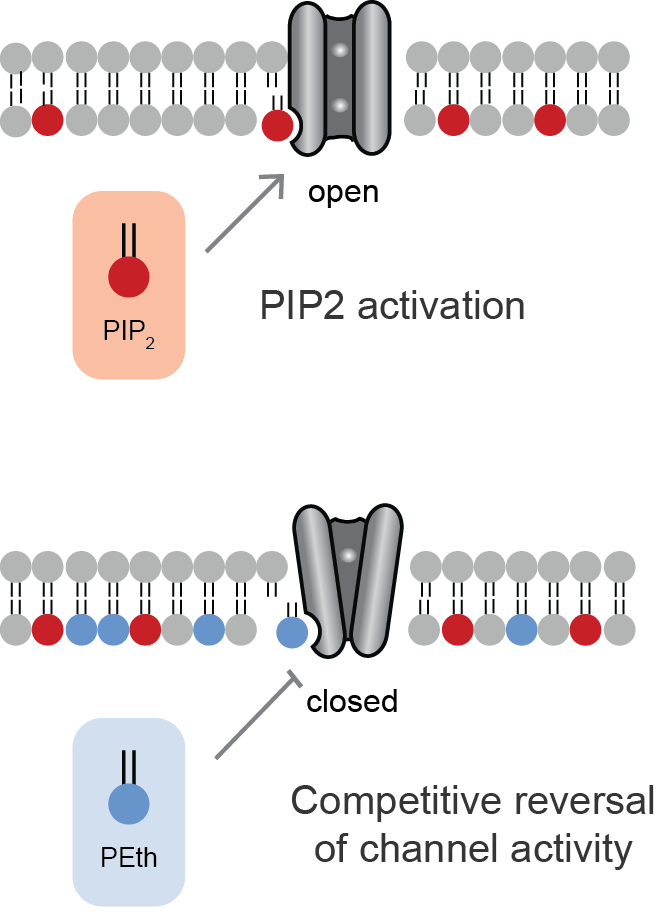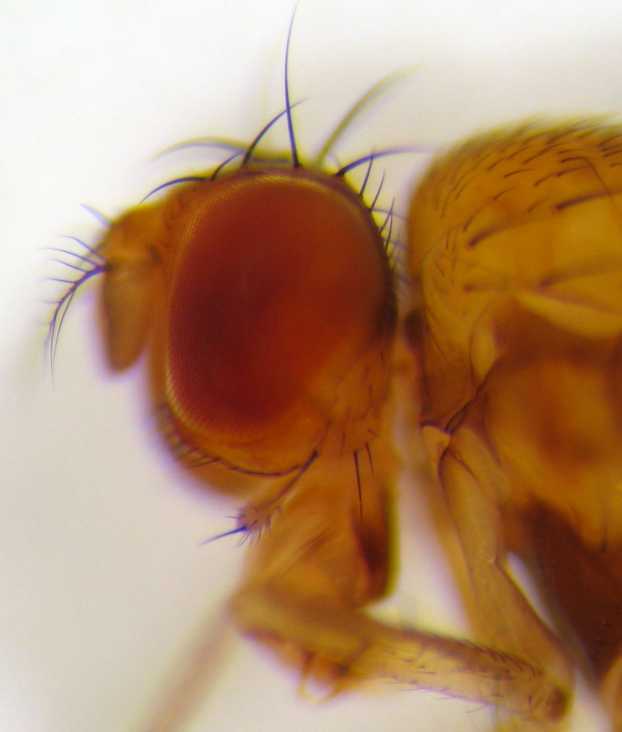|
Kir2.1
The Kir2.1 inward-rectifier potassium channel is a lipid-gated ion channel encoded by the gene. Clinical significance A defect in this gene is associated with Andersen-Tawil syndrome. A mutation in the KCNJ2 gene has also been shown to cause short QT syndrome. In research In neurogenetics, Kir2.1 is used in ''Drosophila'' research to inhibit neurons, as overexpression of this channel will hyperpolarize cells. In optogenetics, a trafficking sequence from Kir2.1 has been added to halorhodopsin to improve its membrane localization. The resulting protein eNpHR3.0 is used in optogenetic research to inhibit neurons with light. Expression of Kir2.1 gene in human HEK293 cells induce a transient outward current, creating a steady membrane potential close to the reversal potential of potassium. Interactions Kir2.1 has been shown to interact with: * DLG4 PSD-95 (postsynaptic density protein 95) also known as SAP-90 (synapse-associated protein 90) is a protein that in ... [...More Info...] [...Related Items...] OR: [Wikipedia] [Google] [Baidu] |
TRAK2
Trafficking kinesin-binding protein 2 is a protein that in humans is encoded by the ''TRAK2'' gene. Interactions TRAK2 has been shown to interact with Kir2.1 The Kir2.1 inward-rectifier potassium channel is a lipid-gated ion channel encoded by the gene. Clinical significance A defect in this gene is associated with Andersen-Tawil syndrome. A mutation in the KCNJ2 gene has also been shown to c ... and GABRB2. References Further reading * * * * * * * * {{gene-2-stub ... [...More Info...] [...Related Items...] OR: [Wikipedia] [Google] [Baidu] |
Halorhodopsin
Halorhodopsin is a seven-transmembrane retinylidene protein from microbial rhodopsin family. It is a chloride-specific light-activated ion pump found in archaea known as halobacteria. It is activated by green light wavelengths of approximately 578 nm. Halorhodopsin also shares sequence similarity to channelrhodopsin, a light-gated ion channel. Halorhodopsin contains the essential light-isomerizable vitamin A derivative all-trans-retinal. Due to the dedication towards discovering the structure and function of this moleculc, halorhodopsin is one of the few membrane proteins whose crystal structure is known. Halorhodopsin uses the energy of green/yellow light to move chloride ions into the cell, overcoming the membrane potential. Beside chlorides it transports other halides and nitrates into the cell. Potassium chloride uptake by cells helps to maintain osmotic balance during cell growth. By performing the same task, light-driven anion pumps can considerably reduce the u ... [...More Info...] [...Related Items...] OR: [Wikipedia] [Google] [Baidu] |
DLG4
PSD-95 (postsynaptic density protein 95) also known as SAP-90 (synapse-associated protein 90) is a protein that in humans is encoded by the ''DLG4'' (discs large homolog 4) gene. PSD-95 is a member of the membrane-associated guanylate kinase (MAGUK) family. With PSD-93 it is recruited into the same NMDA receptor and potassium channel clusters. These two MAGUK proteins may interact at postsynaptic sites to form a multimeric scaffold for the clustering of receptors, ion channels, and associated signaling proteins. PSD-95 is the best studied member of the MAGUK-family of PDZ domain-containing proteins. Like all MAGUK-family proteins, its basic structure includes three PDZ domains, an SH3 domain, and a guanylate kinase-like domain (GK) connected by disordered linker regions. It is almost exclusively located in the post synaptic density of neurons, and is involved in anchoring synaptic proteins. Its direct and indirect binding partners include neuroligin, NMDA receptors, AMPA ... [...More Info...] [...Related Items...] OR: [Wikipedia] [Google] [Baidu] |
Interleukin 16
Interleukin 16 is a pro-inflammatory pleiotropic cytokine. Its precursor, pro-interleukin-16 is a protein that in humans is encoded by the ''IL16'' gene. This gene was discovered in 1982 at Boston University by Dr. David Center and Dr. William Cruikshank. Function The cytokine encoded by this gene is a pleiotropic cytokine that functions as a chemoattractant, a modulator of T cell activation, and an inhibitor of HIV replication. The signaling process of this cytokine is mediated by CD4. The product of this gene undergoes proteolytic processing, which is found to yield two functional proteins. The cytokine function is exclusively attributed to the secreted C-terminal peptide, while the N-terminal product may play a role in cell cycle control. Caspase 3 is reported to be involved in the proteolytic processing of this protein. Two alternatively spliced transcript variants encoding distinct isoforms have been reported. Interleukin 16 (IL-16) is released by a variety of cells (inclu ... [...More Info...] [...Related Items...] OR: [Wikipedia] [Google] [Baidu] |
Inward-rectifier Potassium Channel
Inward-rectifier potassium channels (Kir, IRK) are a specific Lipid-gated_ion_channels, lipid-gated subset of potassium channels. To date, seven subfamilies have been identified in various mammalian cell types, plants, and bacteria. They are activated by phosphatidylinositol 4,5-bisphosphate (Phosphatidylinositol 4,5-bisphosphate, PIP2). The malfunction of the channels has been implicated in several diseases. IRK channels possess a pore domain, homologous to that of voltage-gated ion channels, and flanking transmembrane domain, transmembrane segments (TMSs). They may exist in the membrane as Homo-oligomer, homo- or Hetero-oligomers, heterooligomers and each monomer possesses between 2 and 4 TMSs. In terms of function, these proteins transport potassium, potassium (K+), with a greater tendency for K+ uptake than K+ export. The process of inward-rectification was discovered by Denis Noble in cardiac muscle cells in 1960s and by Richard Adrian, 2nd Baron Adrian, Richard Adrian and Ala ... [...More Info...] [...Related Items...] OR: [Wikipedia] [Google] [Baidu] |
Lipid-gated Ion Channels
Lipid-gated ion channels are a class of ion channels whose conductance of ions through the membrane depends directly on lipids. Classically the lipids are membrane resident anionic signaling lipids that bind to the transmembrane domain on the inner leaflet of the plasma membrane with properties of a classic ligand. Other classes of lipid-gated channels include the mechanosensitive ion channels that respond to lipid tension, thickness, and hydrophobic mismatch. A lipid ligand differs from a lipid Cofactor (biochemistry), cofactor in that a Ligand (biochemistry), ligand derives its function by dissociating from the channel while a cofactor typically derives its function by remaining bound. PIP2-gated channels Phosphatidylinositol 4,5-bisphosphate (PIP2) was the first and remains the best studied lipid to gate ion channels. PIP2 is a cell membrane lipid, and its role in gating ion channels represents a novel role for the molecule. Kir channels: PIP2 binds to and directly activate ... [...More Info...] [...Related Items...] OR: [Wikipedia] [Google] [Baidu] |
Short QT Syndrome
Short QT syndrome (SQT) is a very rare genetics, genetic disease of the electrical system of the heart, and is associated with an increased risk of Heart arrhythmia, abnormal heart rhythms and sudden cardiac death. The syndrome gets its name from a characteristic feature seen on an Electrocardiography, electrocardiogram (ECG) – a shortening of the QT interval. It is caused by mutations in genes encoding ion channels that shorten the cardiac action potential, and appears to be inherited in an autosomal dominant pattern. The condition is diagnosed using a Electrocardiography, 12-lead ECG. Short QT syndrome can be treated using an implantable cardioverter-defibrillator or medications including quinidine. Short QT syndrome was first described in 2000, and the first genetic mutation associated with the condition was identified in 2004. Signs and symptoms Those affected by short QT syndrome (SQT) have an increased risk of developing Heart arrhythmia, abnormal heart rhythms. The ... [...More Info...] [...Related Items...] OR: [Wikipedia] [Google] [Baidu] |
Drosophila
''Drosophila'' (), from Ancient Greek δρόσος (''drósos''), meaning "dew", and φίλος (''phílos''), meaning "loving", is a genus of fly, belonging to the family Drosophilidae, whose members are often called "small fruit flies" or pomace flies, vinegar flies, or wine flies, a reference to the characteristic of many species to linger around overripe or rotting fruit. They should not be confused with the Tephritidae, a related family, which are also called fruit flies (sometimes referred to as "true fruit flies"); tephritids feed primarily on unripe or ripe fruit, with many species being regarded as destructive agricultural pests, especially the Mediterranean fruit fly. One species of ''Drosophila'' in particular, ''Drosophila melanogaster'', has been heavily used in research in genetics and is a common model organism in developmental biology. The terms "fruit fly" and "''Drosophila''" are often used synonymously with ''D. melanogaster'' in modern biological literatur ... [...More Info...] [...Related Items...] OR: [Wikipedia] [Google] [Baidu] |
Hyperpolarization (biology)
Hyperpolarization is a change in a cell's membrane potential that makes it more negative. Cells typically have a negative resting potential, with neuronal action potentials depolarizing the membrane. When the resting membrane potential is made more negative, it increases the minimum stimulus needed to surpass the needed threshold. Neurons naturally become hyperpolarized at the end of an action potential, which is often referred to as the relative refractory period. Relative refractory periods typically last 2 milliseconds, during which a stronger stimulus is needed to trigger another action potential. Cells can also become hyperpolarized depending on channels and receptors present on the membrane, which can have an inhibitory effect. Hyperpolarization is often caused by efflux of K+ (a cation) through K+ channels, or influx of Cl– (an anion) through Cl– channels. On the other hand, influx of cations, e.g. Na+ through Na+ channels or Ca2+ through Ca2+ cha ... [...More Info...] [...Related Items...] OR: [Wikipedia] [Google] [Baidu] |
Optogenetics
Optogenetics is a biological technique to control the activity of neurons or other cell types with light. This is achieved by Gene expression, expression of Channelrhodopsin, light-sensitive ion channels, Halorhodopsin, pumps or Photoactivated adenylyl cyclase, enzymes specifically in the target cells. On the level of individual Cell (biology), cells, Photoactivated adenylyl cyclase, light-activated enzymes and transcription factors allow precise control of biochemical signaling pathways. In Neuroscience, systems neuroscience, the ability to control the activity of a genetically defined set of neurons has been used to understand their contribution to decision making, learning, fear memory, mating, addiction, feeding, and locomotion. In a first medical application of optogenetic technology, vision was partially restored in a blind patient with Retinitis pigmentosa. Optogenetic techniques have also been introduced to map the Brain connectivity estimators, functional connectivity of t ... [...More Info...] [...Related Items...] OR: [Wikipedia] [Google] [Baidu] |
HEK 293 Cells
Human embryonic kidney 293 cells, also often referred to as HEK 293, HEK-293, 293 cells, are an immortalised cell line derived from HEK cells isolated from a female fetus in the 1970s. The HEK 293 cell line has been widely used in research for decades due to its reliable and fast growth and propensity for transfection. The cell line is used by the biotechnology industry to produce therapeutic proteins and viruses for gene therapy as well as safety testing for a vast array of chemicals. History HEK 293 cells were generated in 1973 by transfection of cultures of normal human embryonic kidney cells with sheared adenovirus 5 DNA in Lex van der Eb, Alex van der Eb's laboratory in Leiden, Leiden, the Netherlands. The cells were obtained from a single, aborted or miscarried fetus, the precise origin of which is unclear. The cells were cultured by van der Eb; the transfection with adenoviral DNA was performed by Frank L. Graham, Frank Graham, a Postdoctoral research, post-doc in van der ... [...More Info...] [...Related Items...] OR: [Wikipedia] [Google] [Baidu] |





